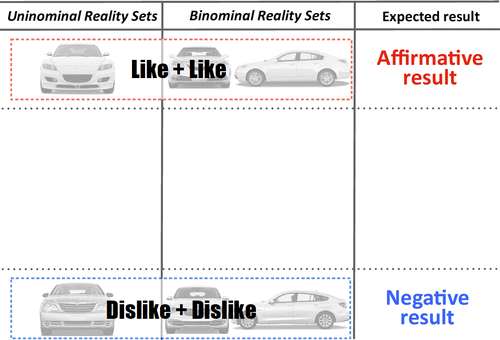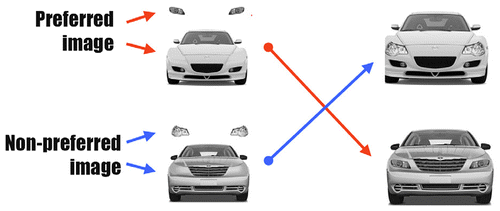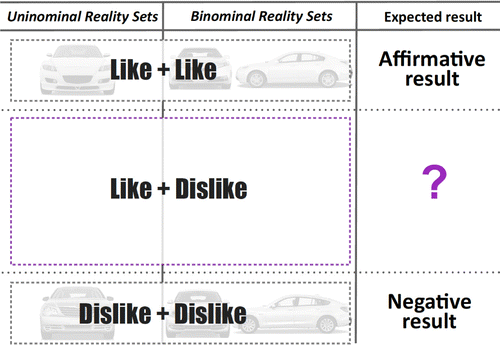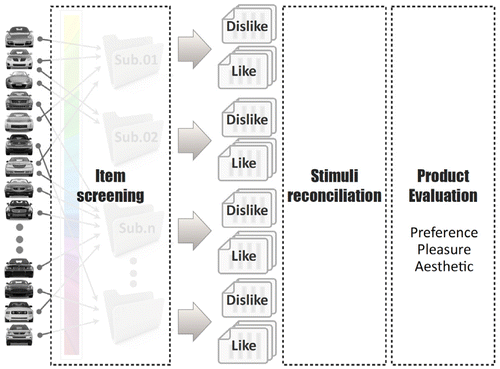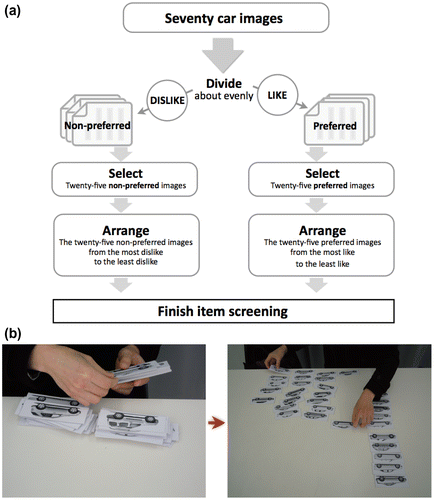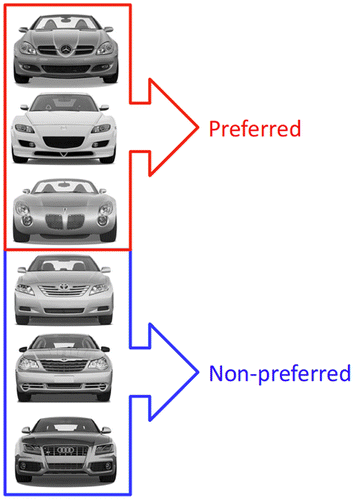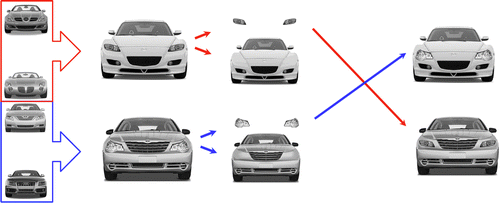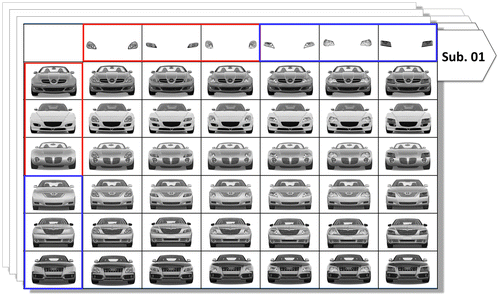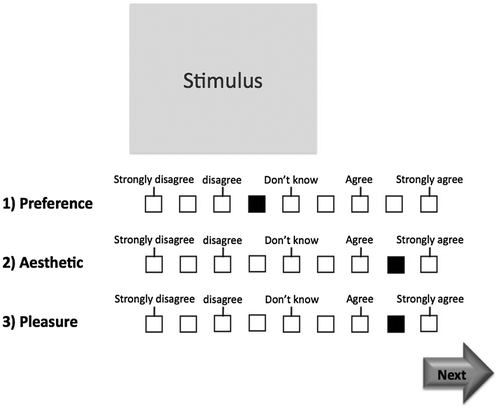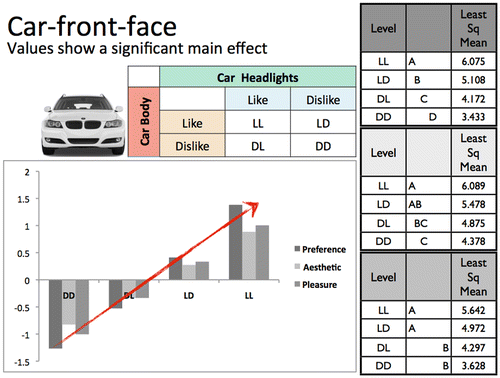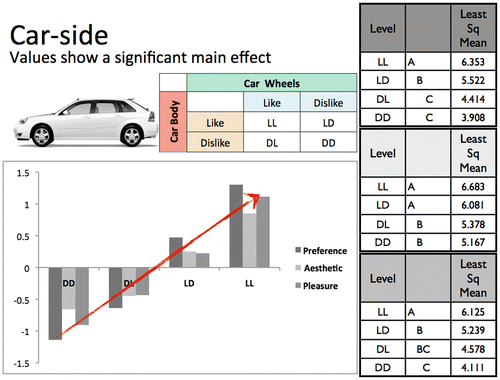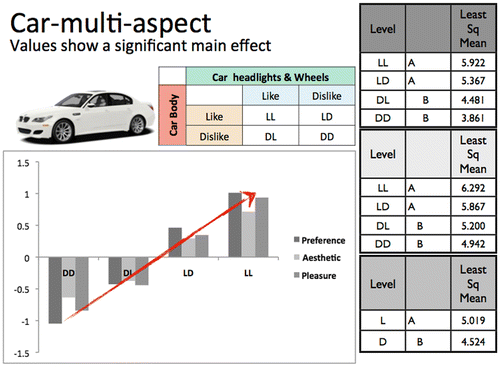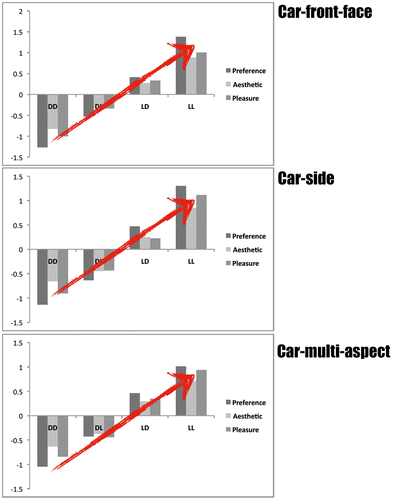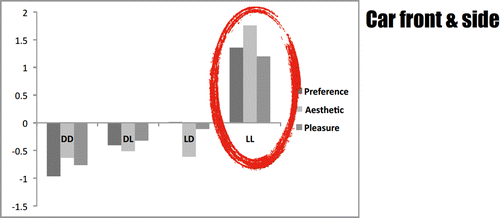Abstract
Due to the changes and complications of emerging society, designers are required not only to know about their design values, but also understand the link between their design and the impacts on the users. This paper aims to show a Kansei focused proposition for sustainable behaviour. By investigating the relationship between Subjective Preference (Like-Dislike) and product evaluation, it shows how affective values, which are used in Kansei engineering researches, influence user’s preferences. In this study, it was considering (1) various factors of product (e.g. the view variation and blackness of products), and (2) Reality Sets (Uninominal–Binominal). Car-front-face, car-side, car-multi-aspect (as Uninominal Reality Sets) and combinations of car front and side (as Binominal Reality Sets) were used as stimuli. The experiment consists of item screening and product evaluation. Subjects were participated in both. The aim of item screening was at selecting subjectively preferred/non-preferred images. Images, which were screened through item screening, were reconciliated per subject. The aim of product evaluation was at investigating if Subjective Preference has related to product evaluation. Semantic Differential method was used as product evaluation method. Evaluation values were preference, aesthetic and pleasure. The findings shows: (1) Subjective Preference is related to product evaluation independently in Uninominal Reality Sets, whereas Subjective Preference is related to product evaluation dependently in Binominal Reality Sets (2) partial preferred images influence product evaluation in Uninominal Reality Sets, whereas Binominal Reality Sets do not influence it.
Introduction
There is currently no accepted definition of Sustainable engineering, but the concept may be assumed by the definition of sustainable. Sustainable is capable of being maintained at a steady level without exhausting natural resources or causing severe ecological damage (Word Reference Citation2016). Sustainable design, green design, sustainable development, design with nature, environmentally sensitive design, environmentally responsible design, environmentally conscious design, green architecture, high-performance buildings and holistic resource management, regardless of what it is called, these terms deal with sustainability, the capability of environmental, economical and social systems being continued over time. Sustainable design has emerged as a guiding paradigm in the creation of a new kind of built environment: one that ‘meets the needs of the present without compromising the ability of future generations to meet their own needs (World Commission on Environment and Development Citation1987)’, and it plans the entire life cycle of a product from its raw material selection to recycle.
Design is a creative activity whose aim is to establish the multi-faceted qualities of objects, processes, services and their systems in whole life cycles. Therefore, design is the central factor of innovative humanization of technologies and the crucial factor of cultural and economic exchange. Design seeks to discover and assess structural, organizational, functional, expressive, and economic relationships. (Definition of Design Citation2016)
This study shares the same purpose with sustainable design by verify the link between product and the impacts on the users focused on affective values. Preference has been addressed as an important theme in design, whereas preference mechanism has not been well explained. This study shows preference mechanism in product evaluation using automotive image considering Subjective Preference. Kansei can contribute to understand this formation. Affective values have been investigated in Kansei studies and used as a tool to capture and convert subjective feelings about a product into concrete design parameters. This is referred to as ‘affective (or Kansei) engineering’. Affective engineering is a field of product design that deals with the translation of consumers’ feelings for a product into design elements (Nagamachi Citation1995, 3–11; Schutte et al. Citation2004, 214–231). Kansei engineering is an affective engineering methodology, in which tools and techniques from a wide variety of fields, such as psychology, ergonomics, information systems, sociology and marketing, are employed in order to link consumers’ feelings and emotions with product properties and translate them into design elements (Yamanaka Citation2011; Kim et al. Citation2012, 945–952). However, for Kansei there is no global agreement on a single definition of the term, even though Kansei engineering has been being used effectively as an affective engineering methodology. Therefore, in this study, the term of Kansei will be used both as it has been understood preciously and the meaning will be refined. Kansei has been developed in Japan in order to design feelings into products, and Kim et al. (Citation2012) defined Kansei as Figure based on the previous Kansei engineering and design studies. The author postulates individual as a subjective innate filter considering the variety of subjectivity. By subjective innate filter, inner and outer separated. When human captors (eyes, ears, nose, etc.) receive a stimulus as an external feature from outer, the sensor data are gathered in Kansei (repository). Kansei (repository) contains full data acquired by subjective innate filter (human sensors); the information synthesizes through in the brain Kansei process); and comes out as reaction such as emotion or intuition (Kansei information). Decision is a result of ‘understanding’. In other words, data in Kansei (as repository) is assimilated (Kansei process), and is sent to understanding process (as Kansei information). Kansei presents as two types of outcome: emotion or intuition as Kansei information per se; decision as a result of understanding. Hence, it hypothesized that preference mechanism can be investigated by comparison between Subjective Preference coming from Kansei, and product evaluation results reflecting Subjective Preference.
Figure 1. A model of Kansei showing how individuals modify their subjective innate filter, suggested by Kim et al. (Citation2012).
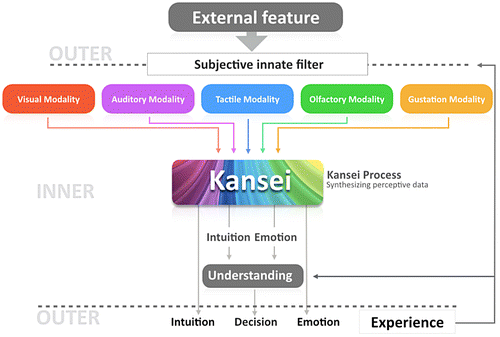
This study investigated (1) the relationship between Subjective Preference and product evaluation, (2) the influences of Reality Sets in product evaluation. The definition of Subjective Preference is not different from preference. The purpose of the re-definition of preference as Subjective Preference was to separate the usage from ‘preference’ in product evaluation. In the product evaluation, ‘preference’ was used as evaluation value. Subjective Preference focused on two types of combination: (1) combination in one image namely Uninominal Reality Sets, (2) combination in two images namely Binominal Reality Sets. Headlights were applied to the reconciliated car-front-face images, whereas wheels were applied to the reconciliated car-side images considering attributions balances between car-front-face and car-side. In car-multi-aspect images, headlights and wheels applied to the reconciliated considering attributions balances of car-front-face and car-side images.
The authors hypothesized that Subjective Preference affects user’s preference of product. It is reasonable to assume that stimuli that consist of subjectively preferred parts to be evaluated affirmatively. On the contrary, it assumed that stimuli that consist of subjectively non-preferred parts to be evaluated negatively (Figure ). It is expected both Uninominal Reality Sets and Binominal Reality Sets.
Then, what about a stimulus involving both the parts which came from a subjectively preferred product image and a subjectively non-preferred product image? Difference from a car image consists of completely like or dislike attribute, what if a car-front-face image consists of preferred car body and non-preferred headlights (Figure )? What if a car-front-face image consists of non-preferred car body and preferred headlights?
People evaluate a car-front-face consisting of preferred and non-preferred forms whether affirmatively or negatively? The scope of this study was to investigate preference mechanism, not only homo-preference but also hetero-preference (Figure ).
Method
The experiment consisted of item screening, stimuli reconciliation and product evaluation. It aimed to investigate if Subjective Preference shows the same mechanism in (1) various views of products (car-front- face, car-side and blackness of products using white–black of same car images), (2) Reality Sets (Uninominal–Binominal; Figure ).
Subjects
Thirty university students (15 females) recruited from University of Tsukuba, Japan. No subjects have taken part in any kind of similar experiment before.
Stimuli
In Uninominal Reality Sets: (1) 70 car-front-face images; (2) 70 car-side images; (3) 70 car-multi-aspect were used. Car-front-face and side aimed to investigate if various view of products was related to product evaluation using preference, aesthetic and pleasure. Car-multi-aspect images aimed to investigate if blackness of products was related to the product evaluation. In Binominal Reality Sets, 70 combinations of car front and side were used. It aimed to investigate if Reality Sets was related to the product evaluation (Figure ).
Experimental process
The item screening aimed to select subjectively preferred/non-preferred images. In item screening task, subjects categorized a card images subjectively preferred group and subjectively non-preferred group almost evenly for each session (i.e. car-front-face, car- side, car-multi-aspect and car front and side). Then, subjects selected 25 most preferred images from preferred category and 25 most non-preferred images from non-preferred category (Figures (a) and (b)).
Through the item screening process, preferred and non-preferred images for each stimuli type (i.e. car-front-face, car-side, car-multi-aspect, and car front and side) were prepared per subject. With these prepared stimuli per subject, experimental stimuli were generated. The process of stimuli producing was as Figure . This process is a part of example of subject in car-front-face.
Preferred and non-preferred images reflecting Subjective Preference of a subject were prepared (Figure ).
The headlights were separated from most preferred and most non-preferred car-front-face images (Figure ).
Generate experimental stimuli with switching each headlights (Figure ). Stimuli were prepared for each subject.
Reconciliated stimuli were used in product evaluation. Subjects evaluated on preference, aesthetic and pleasure with nine scale from strongly disagree to strongly agree for evaluation values (Figure ). Each evaluation is explained as follows:
| (1) | Preference: I like this car. | ||||
| (2) | Aesthetic: The connection of design attributes of this car is good. | ||||
| (3) | Pleasure: I feel happiness while I see this car. | ||||
Data analysis
A 2 × 2 (Subjective Preference in car body × Subjective Preference in car headlights, wheels or headlights and wheels; Subjective Preference in car-front-face × Subjective Preference in car side) two-way mixed-design analysis of variance (ANOVA) was performed to investigate if Subjective Preference was related to product evaluation. Figures shows the factors.
Result and consideration in uninominal reality sets
There was no significant interaction effect in Uninominal Reality Sets.
Car-front-face
There was no significant interaction effect in Uninominal Reality Sets. All evaluation values showed significant main effects in car-front-face images (Table ).
Table 1. Evaluation values showed significant main effects in car-front-face images.
The graph in Figure shows that aesthetic and pleasure were evaluated affirmatively when the stimuli consisted of a car body that came from subjective preferred image. Moreover, it shows a significant main effect in Uninominal Reality Sets. LL and LD showed similar tendency in the product evaluation, affirmative whereas DL and DD showed similar tendency in the product evaluation negatively.
Car-side
All evaluation values showed significant main effects in car-side images (Table ).
Table 2. Evaluation values showed significant main effects in car-side images.
The graph in Figure shows that aesthetic and pleasure were evaluated affirmatively when the stimuli consisted of a car body that came from subjective preferred image. Moreover, it shows a significant main effect in Uninominal Reality Sets. LL and LD were showed similar tendency in the product evaluation affirmatively, whereas DL and DD were showed similar tendency in the product evaluation negatively.
Car-multi-aspect
All evaluation values showed significant main effects in car-multi-aspect images (Table ).
Table 3. Evaluation values showed significant main effects in car-multi-aspect images.
The graph in Figure shows that aesthetic and pleasure were evaluated affirmatively when the stimuli consisted of a car body that came from subjective preferred image. Moreover, it shows the values showed a significant main effect in Uninominal Reality Sets. LL and LD showed similar tendency in the product evaluation, affirmative whereas DL and DD showed similar tendency in the product evaluation negatively.
Result and consideration in uninominal reality sets: car front and side
All evaluation values showed significant main effects. Preference and aesthetic values showed significant interaction effects in Binominal Reality Sets in car front and side images (Table ).
Table 4. Evaluation values showed significant main effects in car front and side images.
The graph is mean rating of standard deviations of preference (Figure ). The graph shows that preference was evaluated negatively when the stimuli include a factor, which came from non-preferred image whether it was car front or side.
Discussion and conclusion
This paper aims to show a Kansei focused proposition for sustainable behaviour. In this study, preference mechanism in product evaluation was verified to show how preference mechanism works on the user’s intuitive and subjective evaluation. By investigating the relationship between Subjective Preference (Like–Dislike) and product evaluation, it shows how affective values influence user’s preferences.
In Uninominal Reality Sets, the results showed the correlation between Subjective Preference in factors (car body, headlights or wheels), and preference in reconciliated images: combinations of non-preferred car body and non-preferred car headlights were evaluated as non-preferred in product evaluation. Combinations of non-preferred car body and preferred car headlights were evaluated as more preferred. Combinations of preferred car body and non-preferred car headlights were evaluated as further more preferred. Combinations of preferred car body and preferred car headlights were evaluated as most preferred (Table ). Furthermore, similar correlations between the attributes of factors and reconciliated images found in aesthetic and pleasure as the same as preference.
Table 5. Correlation between the attributes of factors and reconciliated images in the evaluation values in Uninominal Reality Sets.
Contrary, there was no correlation in Binominal Reality Sets: combinations of non-preferred car-front and non-preferred car-side were evaluated as non-preferred in product evaluation. However, combinations of non-preferred car-front and preferred car-side were evaluated as non-preferred. Combinations of preferred car-front and non-preferred car-side were also evaluated as non-preferred. Only the combinations of preferred car-front and preferred car-side were evaluated as preferred (Table ). Furthermore, similar correlations between the attributes of factors and reconciliated images found in aesthetic and pleasure as the same as preference.
Table 6. Correlation between the attributes of factors and reconciliated images in the evaluation values in Binominal Reality Sets.
It assumed that there is a relationship between the attributes of factors and reconciliated images by Reality Sets. According to the relationship between Subjective Preference of factors and reconciliated images in Uninominal Reality Sets, preferred factors influence the reconciliated images linearly; if conciliated images involve preferred factor, it was evaluated preferred (balanced, pleasant; Table ).
On the other hand, in Binominal Reality Sets, preferred factors influence reconciliated images if it consists of preferred factors only; if the reconciliated images involve non-preferred factor, it was evaluated only non-preferred (unbalanced, unpleasant; Table ). Although subjects were asked to assimilate the separated image as one, they could not: the separated-image could not be integrated as one whole, thereby evaluating as isolated wholes. This finding shows the consequence of assimilation of factors of image as one whole in product evaluation: to be evaluated as more preferred (balanced, pleasant), factors of image should be assimilated as one whole.
It can be interpreted that the relationship between factors of images and reconciliated images with the sign: plus and multiplication. In product evaluation values, i.e. preference, aesthetic and pleasure in Uninominal Reality Sets, plus sign can apply to understand the linear relations: combinations of non-preferred car body and non-preferred car headlights were evaluated as non-preferred (unbalanced, unpleasant). Combinations of non-preferred car body and preferred car headlights were evaluated as more preferred (balanced, pleasant; Table ). On the contrary, in Binominal Reality Sets, multiplication sign can apply to understand the non-linear results: Combinations of non-preferred car-front and non-preferred car-side were evaluated as non-preferred (unbalanced, unpleasant). However, combinations of non-preferred car-front and preferred car-side were evaluated as non-preferred (unbalanced, unpleasant; Table ). Combinations of preferred car-front and non-preferred car-side were also evaluated as non-preferred (unbalanced, unpleasant). Only the combinations of preferred car-front and preferred car-side were evaluated as preferred (balanced, pleasant; Table ).
Table 7. Assumption in the relationship between factors and reconciliated images in Uninominal Reality Sets.
Table 8. Assumption in the relationship between factors and reconciliated images in Binominal Reality Sets.
Considering the difference between one image and separated images, separate images are considered as separated wholes. Although separated images come from one object, the separation isolates the evaluation boundary within one image. In other words, there was a correlation between the attributes of factors and the results of combined factors in product evaluation in Uninominal Reality Sets. On the other hand, there was not a correlation between the attributes of factors and the results of combined factors in Binominal Reality Sets. This relationship is found in not only car body and car headlight but also car body and car wheels; car body and car headlight and wheels. So far, preference can be understood as only be decided on the basis of a number of criteria, and a preference mechanism is not based on a dichotomy between correct and wrong results, but on a scale of degrees of acceptability. The worthy of the findings of this study is that Subjective Preference is related to product evaluation differently by the Reality Sets. If individuals evaluate objects in Binominal Reality Sets, non-preferred part affects its whole impression as non-preferred, non-balanced, non-pleasant. Then, why Subjective Preference is related to product evaluation differently by the Reality Sets? Considering the results from the current study, it can be assumed that while partial factors of reconciliated images influence product evaluation according to the sum of Subjective Preference in Uninominal Reality Sets, partial factors of reconciliated images do not influence product evaluation according to the sum of Subjective Preference in Binominal Reality Sets; whereas in Binominal Reality Sets, partial factors influence product evaluation independently. As a result, while partial factors influence product evaluation in Uninominal Reality Sets as the author hypothesized, partial factors do not influence product evaluation according to the sum of Subjective Preference in Binominal Reality Sets. However, the remaining question is if other products showed the same (at least similar) results as this study?
As further study will be needed to prove if other designed-object images show the same results considering Subjective Preference in Reality Sets differences as the findings (1) Subjective Preference is related to product evaluation independently in Uninominal Reality Sets (Figure ), whereas Subjective Preference is related to product evaluation dependently in Binominal Reality Sets (Figure ), (2) partial preferred images influence product evaluation in Uninominal Reality Sets (Figure ) whereas Binominal Reality Sets did not influence it (Figure ).
Product experience, such as the aesthetic, the emotional, meaning, makes some objects retain their significance over time and in a changing human context and influences attachment to products. It has gained increased interests from design researchers (Chapman Citation2005; Desmet, Hekkert, and Jacobs Citation2000; vol. 19; Desmet and Hekkert Citation2007; vol. 1; Krippendorf Citation2006; Mugge Citation2007; Norman Citation2004; Schifferstein, Mugge, and Hekkert Citation2004). Preference is an affect and how to design preferred products is a more specific design approach concerning user-centred. If from the further study shows the same results as the present study, it will be strongly support sustainability. Because, preference is one of affective sustained value, and the expression of preference by means of choice and decision-making is the essence of intelligent, purposeful behaviour (Slovic Citation1995).
Funding
This study was supported by NEC C&C Foundation Japan.
Disclosure statement
No potential conflict of interest was reported by the authors.
References
- Chapman, J. 2005. Emotionally Durable Design: Objects, Experiences & Empathy. London: Earthscan.
- Definition of Design. 2016. http://www.icsid.org/about/about/articles31.
- Desmet, P., P. Hekkert, and J. Jacobs. 2000. “When a Car Makes You Smile: Development and Application of an Instrument to Measure Product Emotions.” In Advances in Consumer Research, edited by S. J. Hoch and R. J. Meyer, Vol. 19, 111–117. UT: Association for Consumer Research.
- Desmet, P., and P. Hekkert. 2007. “Framework of Product Experience.” International Journal of Design 1 (1): 57–66.
- Kim, S. K., Y. I. Cho, K. Niki, and T. Yamanaka. 2012. “The Influence of Holistic View Impression in Product Evaluation by an Approach in Kansei.” In Proceedings of International Conference on Kansei Engineering and Emotion Research, 945–952.
- Krippendorf, Klaus. 2006. The Semantic Turn. Boca Raton, FL: Taylor & Francis.10.4324/9780203299951
- Mugge, Ruth. 2007. “Product Attachment.” PhD diss., Delft University of Technology.
- Nagamachi, Mitsuo. 1995. “Kansei Engineering: A New Ergonomic Consumer-oriented Technology for Product Development.” International Journal of Industrial Ergonomics 15 (1): 3–11.10.1016/0169-8141(94)00052-5
- Norman, D. A. 2004. Emotional Design. Why We Love (or Hate) Everyday Things. New York: Basic Books.
- Schifferstein, H. N. J., R. Mugge, and P. Hekkert. 2004. “Designing Consumer-product Attachment.” In Design and Emotion: The Experience of Everyday Things, edited by D. McDonagh, P. Hekkert, J. Vanerp, and D. Gyi, 378–383. London: Taylor & Francis.
- Schutte, S., J. Eklund, J. Axelsson, and M. Nagamachi. 2004. “Concepts, Methods and Tools in Kansei Engineering.” Theoretical Issues in Ergonomic Science 5 (3): 214–231.10.1080/1463922021000049980
- Skerlosa, S. J., W. R. Morrowa, and J. J. Michalekb. 2005. “Sustainable Design Engineering and Science: Selected Challenges and Case Studies.” Sustainability Science and Engineering 1: 467–515.
- Slovic, Paul. 1995. “The Construction of Preference.” American Psychology Association 50 (5): 364–371.10.1037/0003-066X.50.5.364
- Word Reference. 2016. Engineering. Word Reference. Accessed January 10, 2016. http://www.wordreference.com/definition/sustainable%20engineering
- World Commission on Environment and Development. 1987. 43.
- Yamanaka, Toshimasa. 2011. “Characteristics of Designer’s Subconscious Evaluation as Kansei Process in Designing.” Paper presented at the International Conference on Design Research (IASDR), Delft, October 31–November 1.

